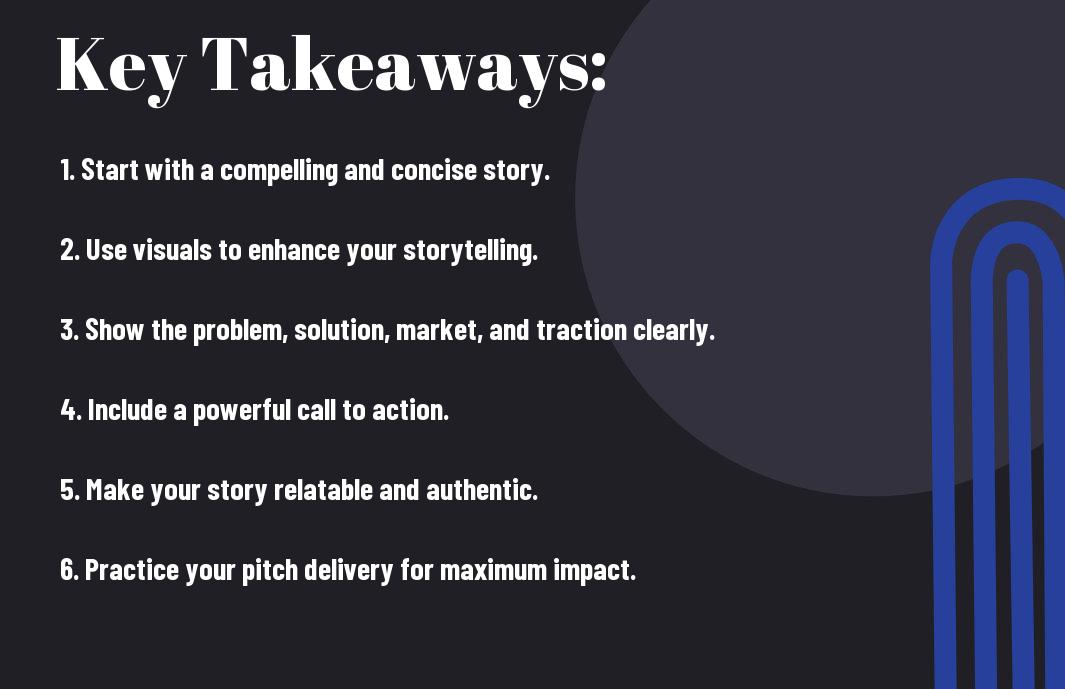Investors are inundated with countless pitch decks, making it crucial for entrepreneurs to stand out and capture their attention. One powerful way to achieve this is through the art of storytelling. Crafting a compelling narrative in your pitch deck can make or break your chances of securing funding. By weaving a story that resonates with investors, you can create an emotional connection that goes beyond numbers and data. In this blog post, we will probe into the importance of storytelling in pitch deck creation and provide tips and strategies to help you craft a narrative that will engage investors and set you apart from the competition.

Crafting Your Narrative
Even the most innovative ideas can fall flat without a compelling story to back them up. Crafting a narrative that resonates with your audience is crucial to standing out in a sea of pitches. To learn more about how to use storytelling in your pitch deck, check out this Startup Guide.
Understanding Your Audience
Your pitch deck’s narrative should be tailored to your audience’s needs and interests. Understanding what drives investors and what they’re looking for will help you shape a story that captivates them from the start.
The Elements of a Compelling Story
Crafting a compelling story involves more than just presenting facts and figures. It’s about creating a journey that showcases your vision, passion, and potential impact. Your story should have a clear beginning, middle, and end, with each slide building on the last to create a seamless narrative.
Plus, don’t forget to infuse your story with emotions and tension to keep investors engaged throughout your pitch deck presentation. By highlighting the problem you’re solving, the solution you’re offering, and the opportunity for growth, you can create a story that investors won’t be able to resist.
Designing Your Pitch Deck
The Role of Visuals in Storytelling
Assuming you want to create a compelling pitch deck, visuals are a crucial element in storytelling. Visuals have the power to capture attention, evoke emotions, and convey complex information quickly and effectively. When designing your pitch deck, choose visuals that complement your narrative and help investors visualize your ideas. Whether it’s using images, charts, graphs, or infographics, make sure your visuals enhance your story and make it memorable.
Balancing Content and Design
Designing a pitch deck involves the delicate balance between content and design elements. While visuals play a significant role in engaging investors, it’s necessary to strike a balance between content and design. Too much visual clutter can distract from your message, while too little visual appeal may fail to grab investors’ attention. It’s crucial to ensure that your content is clear, concise, and impactful, while the design enhances your story without overpowering it.
It’s crucial to keep in mind that investors are looking for a compelling narrative backed by data and visuals. By striking the right balance between content and design, you can effectively communicate your story, capture investors’ interest, and make a lasting impression.
Presenting Your Story
Engaging Your Investors
All successful pitch decks have one thing in common – they tell a compelling story. By presenting a narrative that resonates with investors, you can engage them on an emotional level and stand out from the crowd. Any entrepreneur pitching their idea should focus on crafting a story that highlights the problem their product or service solves, the unique solution they offer, and the market opportunity.
Techniques for Effective Delivery
With respect to delivering your pitch, an entrepreneur must be confident, concise, and clear. Techniques such as maintaining eye contact, using visual aids strategically, and practicing your pitch repeatedly can help you deliver a compelling presentation. Techniques like storytelling, analogies, and humor can make your pitch memorable and impactful.
Refining Your Approach
Gathering Feedback and Iterating
To ensure your pitch deck tells a captivating story, gather feedback from a trusted circle of advisors, colleagues, and mentors. Their insights can provide a fresh perspective and reveal blind spots in your narrative. Iterate based on this feedback to refine your message and address any weaknesses. This iterative process is crucial for creating a pitch deck that resonates with investors.
Learning from Successful Pitches
Gathering inspiration from successful pitches can be a powerful way to enhance your storytelling skills. Watch presentations from renowned entrepreneurs and analyze what made their pitches compelling. Pay attention to their approach to narrative structure, use of visuals, and delivery style. By studying successful examples, you can learn valuable techniques to incorporate into your own pitch deck and increase your chances of engaging investors.
When approaching the task of refining your pitch deck, remember that iteration is key. Solicit feedback from those you trust and be open to making necessary adjustments. Additionally, studying successful pitches can provide valuable insights into what works well in capturing investors’ attention. By honing your storytelling skills and learning from others’ successes, you can craft a compelling narrative that resonates with your audience.

Final Words
Drawing together the elements of storytelling and pitch deck creation is a powerful way to captivate investors and leave a lasting impact. By crafting a compelling narrative that showcases your vision, market opportunity, and team, you can engage investors on an emotional level and communicate the essence of your business in a memorable way. Remember to keep your story authentic, clear, and concise to ensure that your pitch resonates with your audience. So embrace the art of storytelling in your pitch deck creation and watch as your narrative sets you apart and captures the attention of potential investors.
FAQ
Q: What is the importance of storytelling in pitch deck creation?
A: Storytelling in pitch deck creation is crucial as it helps engage investors by creating a narrative that connects with them on a personal level. It allows you to showcase your vision, passion, and the problem you are solving in a compelling way.
Q: How can I effectively incorporate storytelling into my pitch deck?
A: To effectively incorporate storytelling into your pitch deck, start by defining your core message and structuring your presentation around a captivating story arc. Use visuals, anecdotes, and data to support your narrative and make it memorable for investors.
Q: What are the key elements of a compelling narrative in a pitch deck?
A: The key elements of a compelling narrative in a pitch deck include a strong opening that grabs attention, a clear explanation of the problem and your solution, highlighting your unique value proposition, showcasing traction and market opportunity, and ending with a powerful call to action for investors to get involved.
